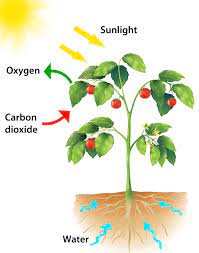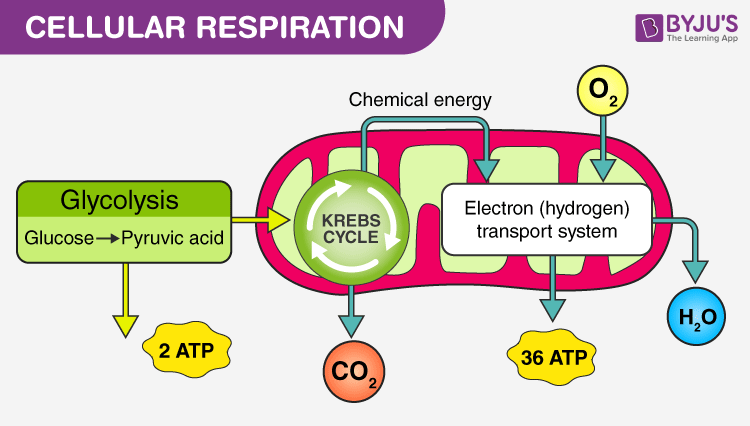Difference between Photosynthesis and RespirationPhotosynthesisAll living organisms depend on photosynthesis since it is the primary source of oxygen in the atmosphere. The carbon cycle, life that requires oxygen, and plants would all perish without photosynthesis. Photosynthesis is the process green plants and trees use to convert sunlight, atmospheric carbon dioxide, and water into food. The oxygen produced by photosynthesis is crucial to human survival. Little to no oxygen would be present on the globe without photosynthesis. 
Reasons why photosynthesis is important
How photosynthesis worksPhotosynthesis requires light energy from the sun, carbon dioxide from the environment, and water from the atmosphere to produce food for plants, trees, algae, and even some bacteria. As a by-product, oxygen is released. These living things' chlorophyll, which also contributes to their green colours, absorbs sunlight, and mixes it with carbon dioxide to create adenosine triphosphate, an organic chemical (ATP). The relationship between energy and living things depends on ATP, which is known as the "energy currency for all life." Importance of cellular respiration to photosynthesisAll living cells have the ability to acquire ATP energy from meals and provide it to the body's essential operations through cellular respiration. All living cells in plants, animals, and people take part in cellular respiration in some capacity. There are three steps involved in cellular respiration. First, a process known as glycolysis occurs in the cytoplasm of the cell to break down glucose, resulting in the formation of two pyruvate molecules from a single glucose molecule and the release of a small amount of ATP. Without utilising oxygen, the cell moves the pyruvate molecules into the mitochondria, the cell's energy hub, in the second phase. The third stage of cellular respiration, known as aerobic respiration, uses oxygen and involves the entry of dietary energy into an electron transport chain, where it produces ATP. In plants, photosynthesis is basically the reverse of cellular respiration. Carbon dioxide is a by-product of oxygen breathing and is released by all living things. During cellular respiration, a plant uses the sun's energy along with the carbon dioxide that people and animals exhale to make the food that it needs. As a result of plants finally releasing oxygen back into the air, humans, animals, and other living things all coexist harmoniously. Non-photosynthetic plantsWhile the majority of plants get their energy through photosynthesis, some do not. The majority of plants that do not make food by photosynthesis are parasitic, which indicates that they depend on a host to generate nutrients. Examples include beech drops (Epiphragms americana), which takes nutrients from beech tree roots, and Indian pipe (Monotropa uniflora), also known as the ghost or corpse plant. Since the Indian pipe plant lacks chlorophyll, it is a ghostly white tint. The mushroom, mould, and yeast kingdoms of plants rely on their surroundings for nourishment rather than photosynthesis. How photosynthesis worksPlants can use the energy from the sun to generate food. This process is known as photosynthesis. Plants use this process to convert sunlight, one type of energy, into sugars, another type of energy that the plant can use more easily as food. Plants require more than just sunlight in order to produce nourishment. In photosynthesis, additional chemical substances are present. They also require carbon dioxide and water, and when they produce sugars, oxygen is a by-product. What is respiration?
When you hear the word "respire," you typically think of breathing. You inhale oxygen and leave carbon dioxide each time you breathe. Respiration is more of a chemical process than breathing, which is a physical motion. Nevertheless, this gas exchange is crucial for respiration. Respiration occurs in every living thing, whether it is a single bacterial cell, a coral reef community, or a blue whale. After food molecules have been ingested, digested, and broken down, the energy that has been produced is used to power the organism's movement and physiological functions. Cells of an organism use the biological process of respiration to obtain energy by combining oxygen and glucose, which releases carbon dioxide, water, and ATP (the currency of energy in cells). According to the equation for cellular respiration, the reactants for aerobic respiration are glucose and oxygen, while the products are carbon dioxide, water, and ATP. Keep track of how many molecules of oxygen, carbon dioxide, and water are used throughout each 'turn' of the operation. Why do we respire?
Respiratory organs of the animalsThe respiratory system in humans is a highly evolved and specialised organ system that includes the lungs. However, different animals breathe through different respiratory organs, which we will go into more depth about. All organisms undergo the same process of exchanging gases during respiration. External or internal, aerobic, or anaerobic respiration are all possible. The classes of organisms according to their manner of respiration are listed below. - 1. Respiration through plasma membrane Every unicellular creature uses its plasma membrane for respiration. Gases are exchanged between these species through the cell surface. By the process of diffusion, they take in oxygen from the environment and release carbon dioxide from the cell surface or the plasma membrane. 2. Respiration through skin Leeches, tapeworms, and earthworms all breathe through their skin. Earthworms have very thin, wet skin that is covered with a large number of blood cells. The term "capillaries" refers to these blood vessels. The exchange of gases happens in these capillaries. This is the reason when their skin dries off, earthworms suffocate to death. 3. Respiration through trachea Tracheae are specialised, tiny tubes that assist in the exchange or transfer of gases in some insects. Every cell in the body receives oxygen once it diffuses into bodily tissue and enters through spiracles into the tracheal tubes. Last but not least, the carbon dioxide that the cells emit enters the tracheal tubes and exits through spiracles. 4. Respiration through gills The majority of aquatic species, including fish and prawns, breathe via unique respiratory systems called gills. The skin's gills are protrusions that house blood vessels that aid in the exchange of gases. They absorb water's dissolved oxygen. Fish breathe by gulping water through their mouths and pumping it over their gills. Water enters the gill chambers through the openings in the gills, and in each chamber, it flows along the filaments. Water is oxygenated by them, and carbon dioxide is substituted for it. 5. Respiration in amphibians Amphibians are unusual species in that they use multiple respiratory organs during their life cycle. In the tadpole stage, they breathe through gills, and as they get older, they breathe both through their skin and their lungs. 6. Respiration through lungs Numerous animals, amphibians, and birds use their lungs to breathe. The chest cavity's lungs are air-filled sac-like organs that are connected to the outside world by a network of tubes and tiny apertures. Difference between Photosynthesis and respiration
Next TopicDifference between
|
 For Videos Join Our Youtube Channel: Join Now
For Videos Join Our Youtube Channel: Join Now
Feedback
- Send your Feedback to [email protected]
Help Others, Please Share










